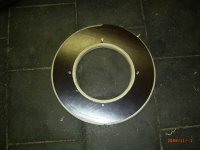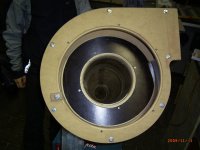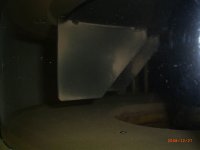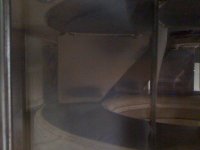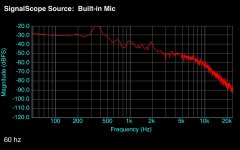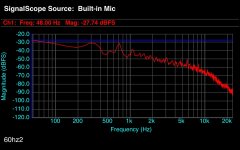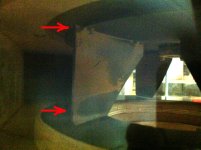Merry Christmas to all
After using my cyclone for two years I was tempted to make a change to the blower. After reading a lot of info on the net I found that fans produce a lot of noise by themselfs and changing the shape at the tip of the wing has a great effect on the sound they produce. The present small rounding on the wingtip is just a little example.
I noticed that the distance between the fan and the bottom of the blower was about 28mm. I wanted to know what would happen if I made the gap smaller like 2mm. (see photo's)
So I made a disk of 430mm (17in) with a hole in the middle to fit inside the blower. The thickness 27mm (18+9mm) made of two sheets of multiplex.
Rounded the edges and screwed the whole thing to the bottom of the blower.
I put the cyclone together again and found that getting the gap even on all sides was not that easy.
I started the cyclone and the sound was completely different. Much softer and less irritating. As far as I can tell the sound not as loud and I have more sucktion.
I have no scientific measurements but the overall result is a cyclone that is to me much better.
Any comments?
Erik
After using my cyclone for two years I was tempted to make a change to the blower. After reading a lot of info on the net I found that fans produce a lot of noise by themselfs and changing the shape at the tip of the wing has a great effect on the sound they produce. The present small rounding on the wingtip is just a little example.
I noticed that the distance between the fan and the bottom of the blower was about 28mm. I wanted to know what would happen if I made the gap smaller like 2mm. (see photo's)
So I made a disk of 430mm (17in) with a hole in the middle to fit inside the blower. The thickness 27mm (18+9mm) made of two sheets of multiplex.
Rounded the edges and screwed the whole thing to the bottom of the blower.
I put the cyclone together again and found that getting the gap even on all sides was not that easy.
I started the cyclone and the sound was completely different. Much softer and less irritating. As far as I can tell the sound not as loud and I have more sucktion.
I have no scientific measurements but the overall result is a cyclone that is to me much better.
Any comments?
Erik

